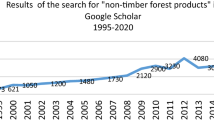Abstract
We evaluated the diversity, social, and economic aspects of nontimber forest product (NTFP) collection in the Nilgiri Biosphere Reserve (NBR), in southern India. The NBR is a region known for its floral andfaunal diversity, as well as an area with increasing human pressure. Fifty to 75% of the households (HH) in rural areas gather a diversity of forest products. Dominant NTFPs contributed 25–60% of the average annual per capita household income from NTFPs. The mean annual per capita household income from NTFPs ranges between Rs. 134 and Rs. 4955. The mean annual income per hectare ranges from Rs. 93 in the montane zone to Rs. 3780 in the moist deciduous. NTFPs contribute 15–50% of the annual per capita income of rural households. Ethnicity plays an important role in the collection of NTFPs and ethnic tribes derive a large proportion of their annual per capita income from NTFPs.
Similar content being viewed by others
Literature Cited
Appasamy, P. 1993. Role of non-timber forest products in a subsistence economy: the case of a joint forestry project in India. Economic Botany 47:258–267.
Bawa, K. S., and R. Godoy. 1993. Introduction to case studies from South Asia. Economic Botany 47:248–250.
Champion, H. G., and S. K. Seth. 1968. A revised survey of forest types of India. Government of India, New Delhi.
Chege, N. 1994. Africa’s non timber forest economy, World Watch, pp. 19-23.
Chopra, K. 1993. The value of non-timber forest products: an estimation for tropical deciduous forests in India. Economic Botany 47:251–257.
Godoy, R. A., D. Wilkie, H. Overman, A. Cubas, G. Cubas, J. Demmer, K. McSweeney, and N. Brokaw. 2000. Valuation of consumption and sale of forest goods from a Central American rain forest. Nature 406:62–63.
Hall, P., and K. S. Bawa. 1993. Methods to asses the impact of extraction of non-timber forest products on plant populations. Economic Botany 47:234–247.
Hegde, R., S. Suryaprakash, L. Achoth, and K. S. Bawa. 1996. Extraction of non-timber forest products in the forests of Biligiri Rangan Hills, India. 1. Contribution to rural income. Economic Botany 50:2443–251.
Hockings, P. 1989. Blue Mountains: the ethnography and biogeography of a south Indian region. Oxford University Press, New Delhi.
—. 1997. Blue Mountains revisited, cultural studies on the Nilgiri Hills. Oxford University Press, New Delhi.
Ganesan, B. 1993. Extraction of non-timber forest products, including fodder and fuelwood, in Mudumalai, India. Economic Botany 47:268–274.
Gunatilake, H. M., A. H. Senaratne, and P. Abeygunawardena. 1993. Role of non-timber forest products in the economy of peripheral comunities of Knuckles National Wilderness Area of Sri Lanka: a farming systems approach. Economic Botany 47:275–281.
Malhotra, K. C. 1992. Joint forestry in West Bengal. Paper presented at a seminar on forests for economic development and recreation. Maxmueller Bhavan, Madras.
Nair, S. S., P. V. Nair, H. C. Sharatchandra, and M. Gadgil. 1977. An ecological reconnaissance of the proposed Jawahar National Park. Journal of Bombay Natural History Society 74:401–435.
NCHSE (National Centre for Human Settlements and Environment). 1987. Documentation on forest and rights. Volume 1. National Centre for Human Settlements and Environment, New Delhi.
Ravindranath, N. H., R. Sukumar, and P. Deshingkar. 1997. Climate change and forests: impacts and adaptation, a regional assessment for the Western Ghats, India. SEI-CES report.
Sukumar, R., H. S. Dattaraja, H. S. Suresh, J. Radhakrishnan, R. Vasudeva, S. Nirmala, and N. V. Joshi. 1992. Long-term monitoring of vegetation in a tropical deciduous forest in Mudumalai, southern India. Current Science 62:608–616.
Tewari, D. D. 1994. Developing and sustaining non timber forest products: policy issues and concerns with special reference to India. Journal of World Forest Resource Management 7:151–178.
Uma Shankar, K. S.Murali, R. lima Shaanker, K. N. Ganeshaiah, and K. S. Bawa. 1996. Extraction of non-timber forest products in the forests of Biligiri Rangan Hills, India. 3. Productivity, extraction and prospects of sustainable harvest of Amla,Phyllanthus emblica (Euphorbiaceae). Economic Botany 50:270–279.
von Lengerke,H. J. 1977. The Nilgiris: weather and climate of a mountain area in south India. Franz Steiner Verlag, Weisbaden.
—,and F. Blasco. 1989. The Nilgiri Environment. Pages 20–78in Paul Hockings, ed., Blue Mountains: the ethnography and biogeography of a south Indian region. Oxford University Press, New Delhi.
Author information
Authors and Affiliations
Rights and permissions
About this article
Cite this article
Narendran, K., Murthy, I.K., Suresh, H.S. et al. Nontimber forest product extraction, utilization and valuation: A case study from the Nilgiri Biosphere reserve, southern India. Econ Bot 55, 528–538 (2001). https://doi.org/10.1007/BF02871715
Received:
Accepted:
Issue Date:
DOI: https://doi.org/10.1007/BF02871715




